牛津译林版八年级下册课件:Unit7study skills(共27张PPT)
文档属性
| 名称 | 牛津译林版八年级下册课件:Unit7study skills(共27张PPT) |  | |
| 格式 | zip | ||
| 文件大小 | 539.2KB | ||
| 资源类型 | 教案 | ||
| 版本资源 | 牛津译林版 | ||
| 科目 | 英语 | ||
| 更新时间 | 2016-09-14 19:33:10 | ||
图片预览

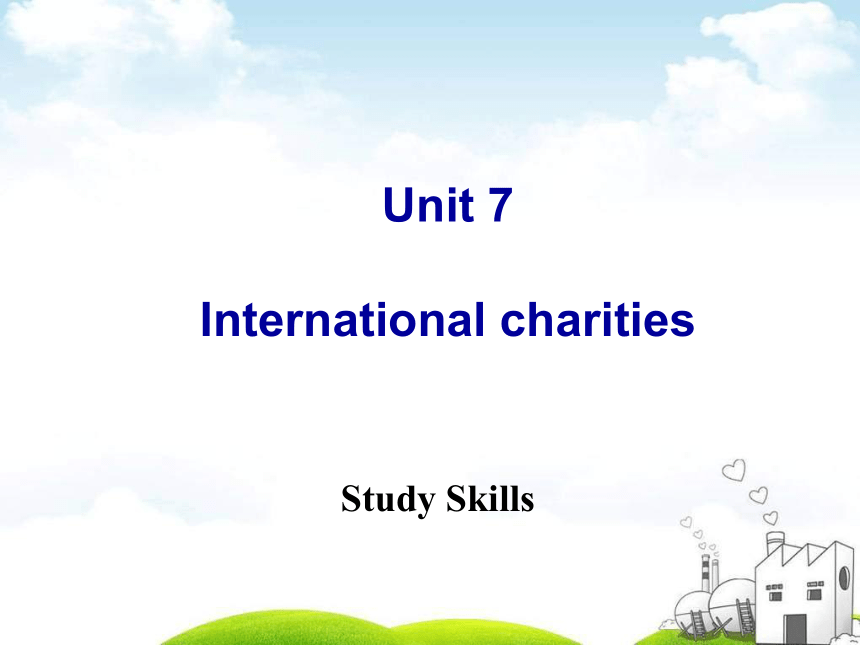
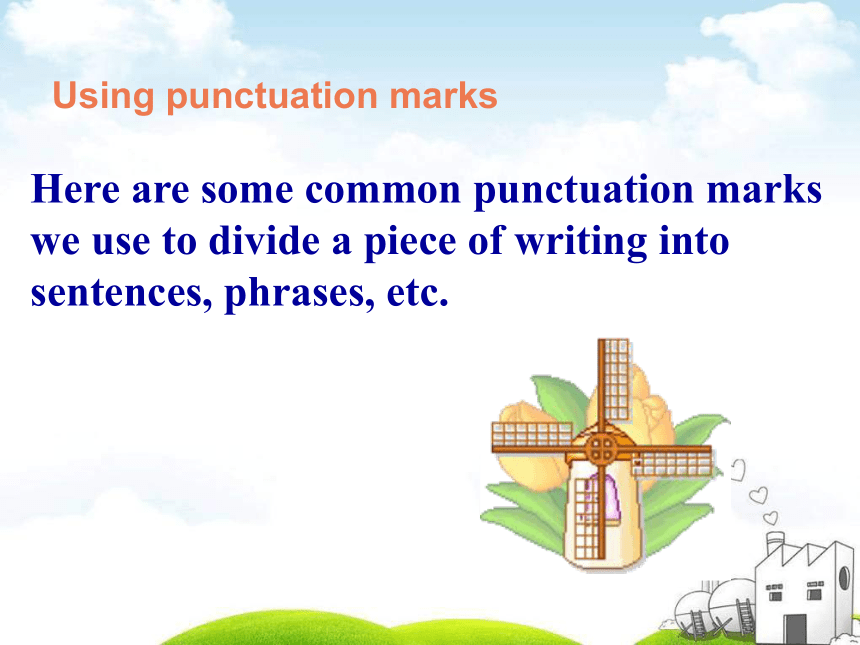

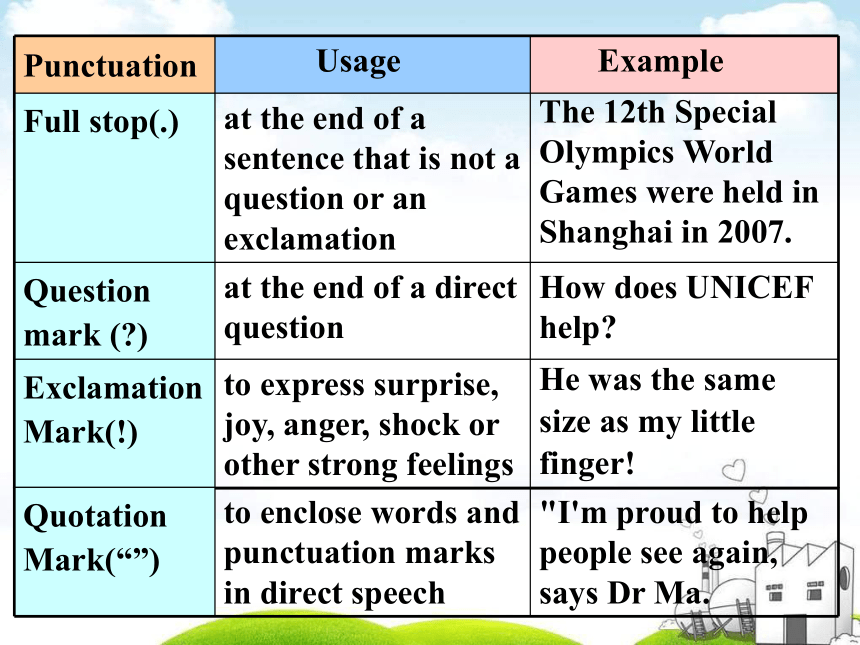
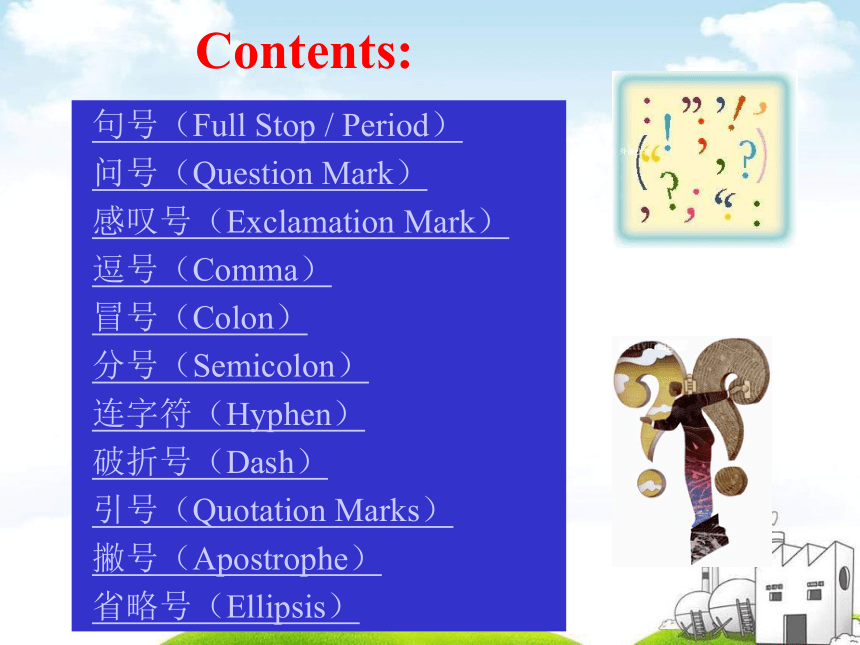
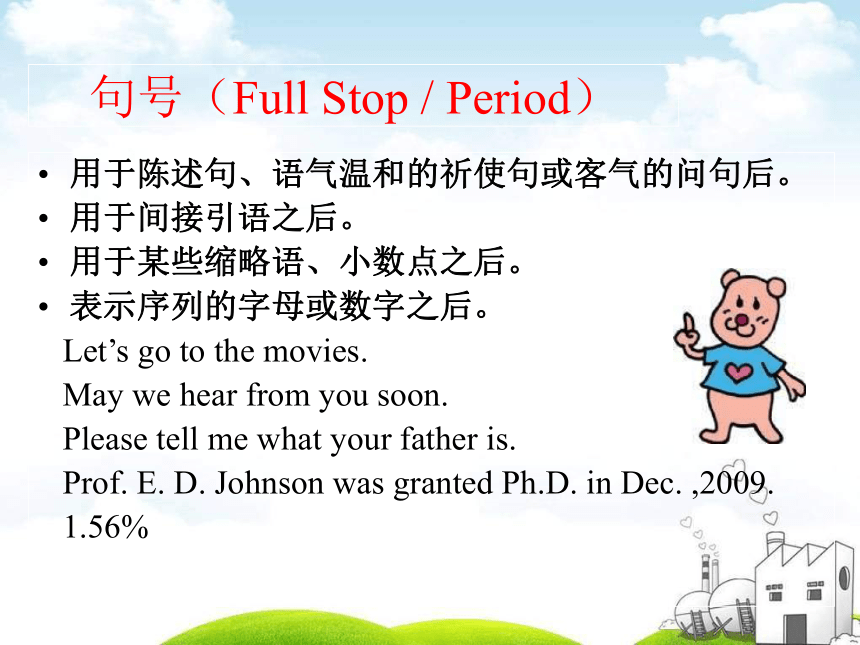
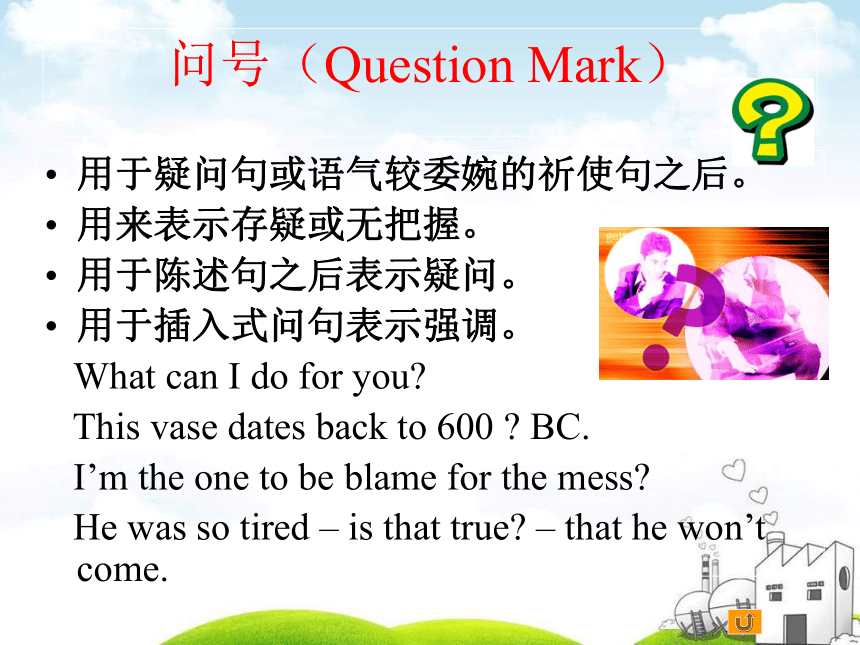
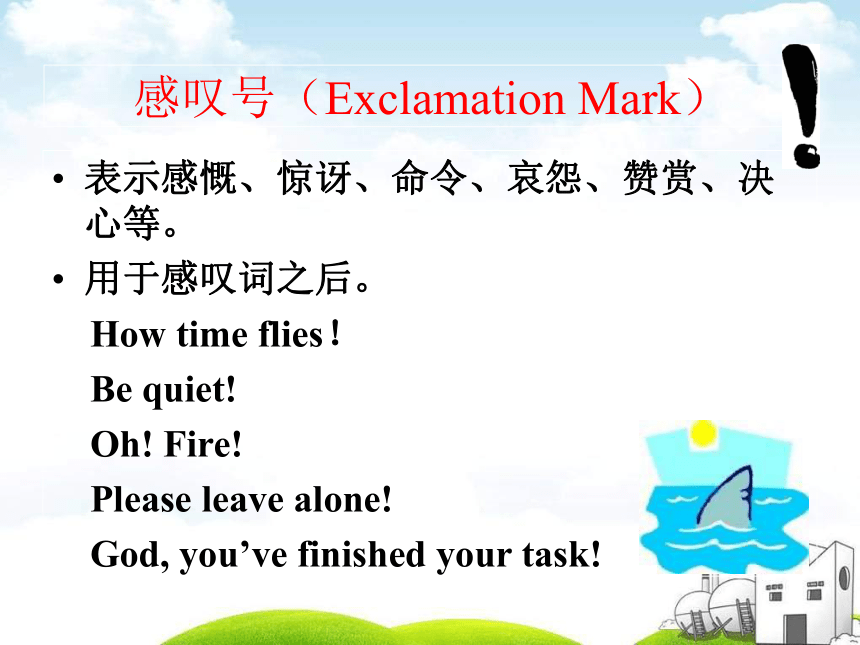
文档简介
课件27张PPT。八年级下册英语教学课件系列Study Skills Unit 7
International charitiesUsing punctuation marksHere are some common punctuation marks we use to divide a piece of writing into sentences, phrases, etc.Contents:句号(Full Stop / Period)
问号(Question Mark)
感叹号(Exclamation Mark)
逗号(Comma)
冒号(Colon)
分号(Semicolon)
连字符(Hyphen)
破折号(Dash)
引号(Quotation Marks)
撇号(Apostrophe)
省略号(Ellipsis)句号(Full Stop / Period)用于陈述句、语气温和的祈使句或客气的问句后。
用于间接引语之后。
用于某些缩略语、小数点之后。
表示序列的字母或数字之后。
Let’s go to the movies.
May we hear from you soon.
Please tell me what your father is.
Prof. E. D. Johnson was granted Ph.D. in Dec. ,2009.
1.56%问号(Question Mark)用于疑问句或语气较委婉的祈使句之后。
用来表示存疑或无把握。
用于陈述句之后表示疑问。
用于插入式问句表示强调。
What can I do for you?
This vase dates back to 600 ? BC.
I’m the one to be blame for the mess?
He was so tired – is that true? – that he won’t come. 感叹号(Exclamation Mark)表示感慨、惊讶、命令、哀怨、赞赏、决心等。
用于感叹词之后。
How time flies!
Be quiet!
Oh! Fire!
Please leave alone!
God, you’ve finished your task!逗号(Comma)用于分割并列成分,相当于汉语中的顿号作用。
用于分割并列句中的分句。
用于分割对比或对照成分。
用于分割非限定性定于从句、同位
语、或附加说明成分。
用于分隔附加疑问句或选择疑问句。
用于分割直接引语及导语。
用于分割句首状语、插入语等。
用于分割日期、数字、地点、人名
与职衔等、(信件)呼语等。例句例句:We’re tired, thirsty and hungry.
We must hurry up, otherwise, we will miss the bus.
No pain, no gain.
He wants us, you and me, to go to his place tomorrow.
John didn’t take it, did he?
Mr. Green said, “Please call on us.”
Frankly, that’s all the money I have.
He left on July 20, 2008, for a trip around the world.
David Smith, Ph.D.冒号(Colon)冒号用于对后面内容的介绍或解释
用于一个正式的引用之前。 也可用于商业或正式信函的称谓后面.
冒号用于数字时间的表示.
冒号用于主标题和副标题之间.
This is her plan: go shopping.
The professor said: “It was horrible.”
4:45 p.m
Web Directory: World and Non-U.S. Economic Data More about punctuations分号(Semicolon)用于并列分句之间。
分隔已经有逗号分割的成分,以免导致歧义。
用于由for example, for instance, namely, that is (to say), in fact, i.e.,等词语引导的句子之前。
Your bike is new; mine is old.
Follow this procedure: first, get your application forms; next, fill them out; last, pay the charge.
His sister is a busy girl; in fact, she works harder than he does.连字符(Hyphen)用于某些前缀后和构成复合词。Job-hunting
构成某些复合数字(100以下的数字应用单词写出,不可用阿拉伯数字代替)
twenty-one , during the years 1949-1999
用于移行, 一般按音节间断开单词加连字号(例如:ha-ppy,不可断为hap-py……),或根据发音,不要把单个字母留在行尾或行首。注意一页中最后一个单词不能使用连字号将其置于两页。破折号(Dash)用于话语突然中断、意思转折或犹豫不决。
用作解释。
用于被强调部分。
引出概括性词语或表示引文出处。
用于两地名或两时间之间,相当于连字号。
“I’d like to,” he said, “but I’m –”
Money, fame, power – these are his goals in life.
What he needed most he never got – love.
London – New York flight引号(Quotation Marks)引用书面或口头的直接引语。
引用事物的名称。
引用俚语、反语、定义、词形等。
引用对话。
表示强调。
Bob said, “Let’s meet at my house next time.”
Have you read the novel “Flying”?
How do you spell the word “souvenir”?
“Did you have a great time last night?”撇号(Apostrophe)省字符。
表示某些特殊结构的复数形式。
表示名词的所有格。
you’d better = you had better
today’s news, a friend of my father’s 省略号(Ellipsis)表示词语或句子的有意省略。
表示断断续续、停顿、犹豫不决。
表示没有说完的话语。
用以分割词组,加强语气。
“…the book is lovely and well written.”
“Tell … mother … I … died … for … my country.”
Do it soon… Do it today … Do it now.
“I don’t know… I don’t know.”中英文标点符号的差异⒈ 汉语中的某些标点符号为英语所没有。
⑴ 顿号(、):顿号在汉语中起分割句子中的并列成分的作用;英语中没有顿号,分割句中的并列成分多用逗号。如:
She slowly, carefully, deliberately moved the box.
注意:
类似的情况下,最后一个逗号后可加and,这个逗号也可省略--She slowly, carefully(,) and deliberately moved the box. ⑵间隔号:汉语有间隔号,用在月份和日期、音译的名和姓等需要隔开的词语的正中间,如“一二·九”、“奥黛丽·赫本(人名)”等。英语中没有汉语的间隔号,需要间隔时多用逗点。
⑶ 书名号(《》):英文没有书名号,书名、报刊名用斜体或者下划线表示。如:
Hamlet 《哈姆雷特》
Winter‘s Tale / Winter‘s Tale 《冬天的童话》
另外,英语中文章、诗歌、乐曲、电影、绘画等的名称和交通工具、航天器等的专有名词也常用斜体来表示。 ⒉ 英语中的某些标点符号为汉语所没有。 ⑴ 撇号--Apostrophe(‘)
⑵ 连字号--Hyphen(-)
⑶ 斜线号—Virgule or Slash(/):该符号主要起分割作用。
It could be for staff and / or students.
也常用于标音,如bed /bed/。 ⒊ 某些符号在汉英两种语言中的形式不同。⑴ 中文的句号是空心圈(。)
英文的句号是实心点(.)。
⑵ 英文的省略号是三个点(...),位置在行底;中文的为六个点(......),居于行中。
⑶ 英文的破折号是( – )
中文的是(—)A charity showMillie has written about her experience as a host of a charity show. Help her
add the correct punctuation marks., . ? ! “”The big day came very quickly and suddenly it was the night before the charity show I could not sleep at all that night because I was so excited Will it be a success I kept asking myself
Twenty minutes before the big event the doors opened and many people came into the theatre
No time to be nervous any more This is it
I told myself A lot of people came to watch the show They were making a lot of noise so I had to speak loudly,..“?”,.“.!”..,..Homework Review the common punctuation marks.
Pay more attention to their usage(用法).
And preview the next part.Thank you!
International charitiesUsing punctuation marksHere are some common punctuation marks we use to divide a piece of writing into sentences, phrases, etc.Contents:句号(Full Stop / Period)
问号(Question Mark)
感叹号(Exclamation Mark)
逗号(Comma)
冒号(Colon)
分号(Semicolon)
连字符(Hyphen)
破折号(Dash)
引号(Quotation Marks)
撇号(Apostrophe)
省略号(Ellipsis)句号(Full Stop / Period)用于陈述句、语气温和的祈使句或客气的问句后。
用于间接引语之后。
用于某些缩略语、小数点之后。
表示序列的字母或数字之后。
Let’s go to the movies.
May we hear from you soon.
Please tell me what your father is.
Prof. E. D. Johnson was granted Ph.D. in Dec. ,2009.
1.56%问号(Question Mark)用于疑问句或语气较委婉的祈使句之后。
用来表示存疑或无把握。
用于陈述句之后表示疑问。
用于插入式问句表示强调。
What can I do for you?
This vase dates back to 600 ? BC.
I’m the one to be blame for the mess?
He was so tired – is that true? – that he won’t come. 感叹号(Exclamation Mark)表示感慨、惊讶、命令、哀怨、赞赏、决心等。
用于感叹词之后。
How time flies!
Be quiet!
Oh! Fire!
Please leave alone!
God, you’ve finished your task!逗号(Comma)用于分割并列成分,相当于汉语中的顿号作用。
用于分割并列句中的分句。
用于分割对比或对照成分。
用于分割非限定性定于从句、同位
语、或附加说明成分。
用于分隔附加疑问句或选择疑问句。
用于分割直接引语及导语。
用于分割句首状语、插入语等。
用于分割日期、数字、地点、人名
与职衔等、(信件)呼语等。例句例句:We’re tired, thirsty and hungry.
We must hurry up, otherwise, we will miss the bus.
No pain, no gain.
He wants us, you and me, to go to his place tomorrow.
John didn’t take it, did he?
Mr. Green said, “Please call on us.”
Frankly, that’s all the money I have.
He left on July 20, 2008, for a trip around the world.
David Smith, Ph.D.冒号(Colon)冒号用于对后面内容的介绍或解释
用于一个正式的引用之前。 也可用于商业或正式信函的称谓后面.
冒号用于数字时间的表示.
冒号用于主标题和副标题之间.
This is her plan: go shopping.
The professor said: “It was horrible.”
4:45 p.m
Web Directory: World and Non-U.S. Economic Data More about punctuations分号(Semicolon)用于并列分句之间。
分隔已经有逗号分割的成分,以免导致歧义。
用于由for example, for instance, namely, that is (to say), in fact, i.e.,等词语引导的句子之前。
Your bike is new; mine is old.
Follow this procedure: first, get your application forms; next, fill them out; last, pay the charge.
His sister is a busy girl; in fact, she works harder than he does.连字符(Hyphen)用于某些前缀后和构成复合词。Job-hunting
构成某些复合数字(100以下的数字应用单词写出,不可用阿拉伯数字代替)
twenty-one , during the years 1949-1999
用于移行, 一般按音节间断开单词加连字号(例如:ha-ppy,不可断为hap-py……),或根据发音,不要把单个字母留在行尾或行首。注意一页中最后一个单词不能使用连字号将其置于两页。破折号(Dash)用于话语突然中断、意思转折或犹豫不决。
用作解释。
用于被强调部分。
引出概括性词语或表示引文出处。
用于两地名或两时间之间,相当于连字号。
“I’d like to,” he said, “but I’m –”
Money, fame, power – these are his goals in life.
What he needed most he never got – love.
London – New York flight引号(Quotation Marks)引用书面或口头的直接引语。
引用事物的名称。
引用俚语、反语、定义、词形等。
引用对话。
表示强调。
Bob said, “Let’s meet at my house next time.”
Have you read the novel “Flying”?
How do you spell the word “souvenir”?
“Did you have a great time last night?”撇号(Apostrophe)省字符。
表示某些特殊结构的复数形式。
表示名词的所有格。
you’d better = you had better
today’s news, a friend of my father’s 省略号(Ellipsis)表示词语或句子的有意省略。
表示断断续续、停顿、犹豫不决。
表示没有说完的话语。
用以分割词组,加强语气。
“…the book is lovely and well written.”
“Tell … mother … I … died … for … my country.”
Do it soon… Do it today … Do it now.
“I don’t know… I don’t know.”中英文标点符号的差异⒈ 汉语中的某些标点符号为英语所没有。
⑴ 顿号(、):顿号在汉语中起分割句子中的并列成分的作用;英语中没有顿号,分割句中的并列成分多用逗号。如:
She slowly, carefully, deliberately moved the box.
注意:
类似的情况下,最后一个逗号后可加and,这个逗号也可省略--She slowly, carefully(,) and deliberately moved the box. ⑵间隔号:汉语有间隔号,用在月份和日期、音译的名和姓等需要隔开的词语的正中间,如“一二·九”、“奥黛丽·赫本(人名)”等。英语中没有汉语的间隔号,需要间隔时多用逗点。
⑶ 书名号(《》):英文没有书名号,书名、报刊名用斜体或者下划线表示。如:
Hamlet 《哈姆雷特》
Winter‘s Tale / Winter‘s Tale 《冬天的童话》
另外,英语中文章、诗歌、乐曲、电影、绘画等的名称和交通工具、航天器等的专有名词也常用斜体来表示。 ⒉ 英语中的某些标点符号为汉语所没有。 ⑴ 撇号--Apostrophe(‘)
⑵ 连字号--Hyphen(-)
⑶ 斜线号—Virgule or Slash(/):该符号主要起分割作用。
It could be for staff and / or students.
也常用于标音,如bed /bed/。 ⒊ 某些符号在汉英两种语言中的形式不同。⑴ 中文的句号是空心圈(。)
英文的句号是实心点(.)。
⑵ 英文的省略号是三个点(...),位置在行底;中文的为六个点(......),居于行中。
⑶ 英文的破折号是( – )
中文的是(—)A charity showMillie has written about her experience as a host of a charity show. Help her
add the correct punctuation marks., . ? ! “”The big day came very quickly and suddenly it was the night before the charity show I could not sleep at all that night because I was so excited Will it be a success I kept asking myself
Twenty minutes before the big event the doors opened and many people came into the theatre
No time to be nervous any more This is it
I told myself A lot of people came to watch the show They were making a lot of noise so I had to speak loudly,..“?”,.“.!”..,..Homework Review the common punctuation marks.
Pay more attention to their usage(用法).
And preview the next part.Thank you!
